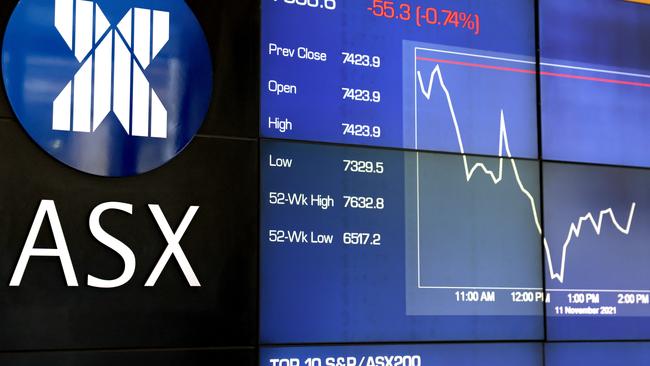Tilt your portfolios to shape up for stagflation
You can’t hide from stagflation if it hits, but you can redesign your investment portfolio to prepare a defence.

Business
Don't miss out on the headlines from Business. Followed categories will be added to My News.
I don’t claim to know how the conflict in Ukraine will be resolved, nor when. Investors, however, should consider the outcomes of both a short conflict and a more protracted one.
Before the war, markets were processing the inevitability of rising interest rates alongside the reality of accelerating inflation driven by material pent-up demand and a logistics system struggling to cope.
On the one hand investors remained optimistic about rising demand for both goods and services such as travel, leisure and entertainment, but pessimistic about the implications for valuations from rising interest rates.
The invasion of Ukraine by Russia creates a more acute tension between the bulls and bears.
Putting aside the low probability of an all-out global conflict, the impact on commodity prices and supply from the war are realities that will affect global growth.
Importantly, declines in supply of commodities – oil, for example – have a more profound negative effect on economic growth than rising prices, which of course are surging. Supply chains were already stretched prior to Vladimir Putin’s war. The conflict, and the resulting sanctions, have made the situation only worse.
And that brings us to the rather sensational topic of stagflation.
If the war drags on – as might be expected from a guerrilla war with Ukrainians supplied militarily by Europe, the US and their allies – the potential is high for slowing global growth and continued high levels of inflation.
For some major economies, that means potentially a recession and stagflation (defined as persistent high inflation combined with slow economic growth).
Already inflation expectations, as measured by 10-year break-even yields, are at the highest level on record. Meanwhile, a slowing economy – due to constrained supply of commodities and declining consumer confidence – is an increasing probability.
The first question investors might ask is whether selling out and turning to the safety of cash is a serious option. The purchasing power of cash erodes much more quickly in an inflationary environment. An investor is guaranteed to lose wealth through the erosion of purchasing power if cash is held.
In any case, timing markets successfully is frightfully difficult if not impossible. Returns from equities have proved to be superior to cash over the long term. Even during the two world wars equity returns were positive (as measured by the Dow Jones).
However, investors can tilt or shape portfolios, for example reducing the proportion of “moon shots” (which should also be relatively small) and increasing the proportion of high-quality businesses with pricing power (those able to pass on to consumers the higher costs of production and supply).
Companies enjoying inelastic demand for their services might easily be described as defensive, and appropriately so. One cannot be sure share prices will remain stable, but invariably they will reflect their defensive characteristics as more investors catch on.
Periods of coincident accelerating inflation, rising interest rates and geopolitical turmoil do not naturally lend themselves to confidence, and equity markets are prone to being influenced by sentiment. Nevertheless, history does suggest companies with certain characteristics fare better.
According to recent research conducted by UBS into market performances historically, when inflation is high a “modest downshift in growth” doesn’t have a significant negative impact on US market returns. Returns drop more sharply when growth slows even more sharply. This is consistent with a mountain of research that shows recessions tend to be the bearer of bad tidings for markets.
But as just mentioned, some companies and sectors do better than others. This is also reflected in the UBS research.
In a state of stagflation the US industries that historically outperformed the market were food staples and retailing, hygiene, healthcare and personal products, pharma and biotech, banks, real estate and energy. Meanwhile, industries that underperformed were communication services, information technology, autos, insurance, capital goods and utilities.
Finally, UBS dug a little deeper to explore which sectors witnessed the most significant changes in returns when the economy moved from a high growth/high inflation environment (which is where we have just been) to high inflation/moderate-to-low growth.
UBS found energy, materials, tech, retailing, autos and consumer durables see a sharp deterioration in returns, even if energy still outperforms the market (watch out Woodside and BHP investors).
Defensive sectors such as food, beverages and tobacco, pharma and financials produced the best relative returns. If there is another step down in growth – and stagflation becomes a reality – all sectors lose ground, including defensives, but returns in tech, energy and real estate fare the worst.
So, a protracted battle in Ukraine, which appears most likely, could trigger sustained increases in the prices of some commodities, but more importantly constrain supply. Consequent slowing economic growth, while inflation remains high, has stagflation as a realistic prospect. And historically slowing growth, amid rising consumer prices, has been better for some sectors than others. But instead of heading for the exit door, investors may consider the merits of a portfolio tilt.
Roger Montgomery is founder and chief investor at Montgomery Investment Management.
Originally published as Tilt your portfolios to shape up for stagflation



